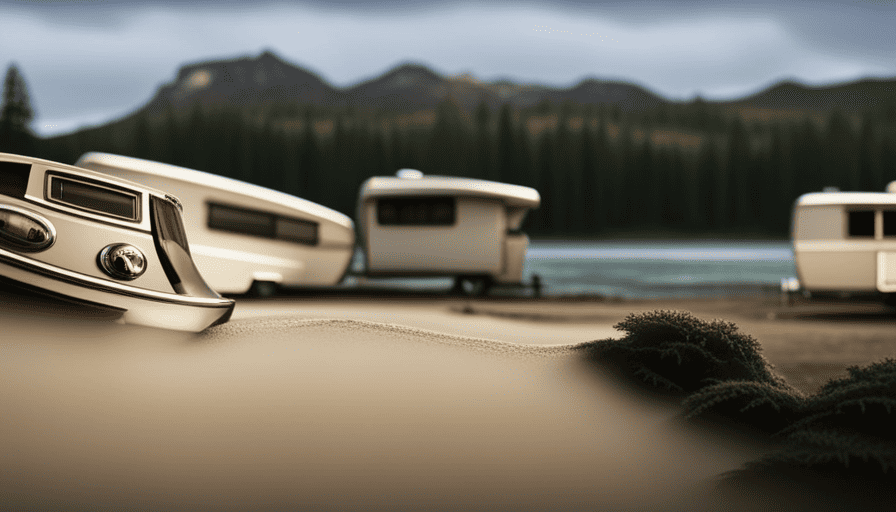Are you prepared for your upcoming camping trip? Your camper is packed with everything you need, you’re holding onto maps, and there’s an air of anticipation surrounding you. However, have you inspected the wheel bearings on your camper?
Now, I know what you’re thinking. ‘Why should I bother checking my camper wheel bearings? They’re just a small part of the overall picture.’nnWell, my friend, let me tell you something. Those tiny bearings play a crucial role in keeping your camper safe and ensuring smooth travels on the road.
In this article, I’m going to show you how to check your camper wheel bearings like a pro.nnWe’ll cover everything from gathering the necessary tools to monitoring for signs of wear and tear.nnSo, grab your toolbox and let’s get started.nnTrust me, your camper will thank you for it!
Key Takeaways
- Proper maintenance and inspection of camper wheel bearings is crucial for safe and smooth travels.
- Signs of worn out bearings include unusual noise, wobbly sensation while driving, and uneven tire wear.
- Regularly clean, inspect, and grease the wheel bearings to prevent failure and ensure optimal performance.
- Follow proper lifting techniques and torque specifications when checking and reassembling the wheel bearings.
Importance of Regularly Checking Camper Wheel Bearings
Regularly checking your camper’s wheel bearings is crucial for ensuring safe and smooth travels. Proper wheel alignment and functioning bearings are essential for maintaining control and stability while on the road. When your wheel bearings are in good condition, they allow the wheels to rotate smoothly and reduce friction, preventing unnecessary wear and tear.
On the other hand, worn out bearings can lead to serious issues such as overheating, excessive tire wear, and even wheel detachment.
To determine if your camper’s wheel bearings need attention, there are a few signs to look out for. First, if you notice any unusual noise coming from the wheels, such as grinding or squeaking, it could indicate that the bearings are worn out and need to be replaced. Additionally, if you experience a wobbly or shaky sensation while driving, it might be a sign of improper wheel alignment or damaged bearings.
Now that you understand the importance of regularly checking your camper’s wheel bearings, it’s time to gather the necessary tools and equipment for the inspection.
Gather the Necessary Tools and Equipment
First, you’ll want to make sure you have all the tools and equipment necessary for this task, such as a jack, lug wrench, and a pair of gloves. Did you know that improper maintenance of bearings can lead to a 41% increase in accidents? It’s important to regularly check your camper wheel bearings to ensure safe and smooth travels.
Here are some common signs of worn out wheel bearings to look out for:
- Excessive noise: If you hear a grinding or humming noise coming from your wheels, it could be a sign of worn out bearings.
- Uneven tire wear: Uneven tread wear can indicate that your bearings are not working properly, causing uneven weight distribution on your tires.
- Wheel vibration: If you feel a vibration in your steering wheel or seat, it may be due to worn out wheel bearings.
To properly check your camper wheel bearings, you’ll need to jack up the camper and remove the wheel. This will allow you to access the bearings for inspection and maintenance.
Jack Up the Camper and Remove the Wheel
Next, you’ll need to lift the camper using a jack and take off the wheel. Before attempting to lift the camper, it’s crucial to follow proper lifting techniques to avoid accidents and ensure your safety.
Make sure the camper is parked on a level surface and engage the parking brake to prevent any movement. Place the jack under the designated lifting point on the frame of the camper, ensuring it’s stable and secure. Slowly pump the jack to raise the camper off the ground, being cautious not to exceed the jack’s weight capacity.
Once the camper is lifted, use a lug wrench to remove the wheel by loosening the lug nuts in a diagonal pattern.
While inspecting the wheel bearings, it’s also important to examine the brake system for any issues. Look for signs of wear or damage, such as uneven brake pad wear or leaking brake fluid. Any abnormalities should be addressed promptly to ensure the safety of your camper.
Clean and inspect the wheel hub and bearings for any debris or signs of wear. This will allow you to identify any potential problems that could affect the performance of your camper’s wheel bearings.
Clean and Inspect the Wheel Hub and Bearings
To properly maintain your camper’s wheel hub and bearings, start by thoroughly cleaning and inspecting them for any signs of debris or wear.
Begin by removing the wheel from the camper using a jack and lug wrench. Once the wheel is off, visually inspect the wheel hub for any dirt, grime, or excessive grease buildup. Use a degreaser and a brush to clean the hub, ensuring that all surfaces are free from debris.
Next, inspect the wheel bearings for any signs of damage or wear, such as pitting, rust, or excessive play. Rotate the bearings by hand to check for smooth operation and listen for any unusual noises. If any issues are found, it’s recommended to replace the bearings.
Finally, transition into the next section by mentioning that after cleaning and inspecting the wheel hub and bearings, the next step is to grease the bearings for smooth operation.
Grease the Bearings for Smooth Operation
Now it’s time to give those bearings some love and grease them up for a smooth and worry-free ride. Properly greasing the bearings is crucial for preventing bearing failure and ensuring optimal performance.
Here are three key steps to grease the bearings effectively:
-
Clean the bearings: Before applying grease, it’s essential to clean the bearings thoroughly. Remove any old grease or dirt using a solvent or degreaser. Inspect the bearings for signs of wear, pitting, or damage. Replace any worn-out bearings to prevent future issues.
-
Apply the grease: Once the bearings are clean and dry, it’s time to apply fresh grease. Use a high-quality wheel bearing grease that meets the manufacturer’s specifications. Apply a liberal amount of grease to each bearing, ensuring it gets into all the nooks and crannies.
-
Distribute the grease evenly: To ensure proper lubrication, distribute the grease evenly throughout the bearing. Rotate the bearing while applying pressure to work the grease into the rollers. Make sure there are no dry spots or excess grease.
Inadequate lubrication can lead to bearing failure, causing excessive heat, noise, and vibration. By greasing the bearings properly, you can prevent these issues and enjoy a smoother ride.
Now that the bearings are greased, it’s time to reassemble the wheel and tighten the lug nuts, ensuring everything is secure before hitting the road again.
Reassemble the Wheel and Tighten the Lug Nuts
After giving your bearings some much-needed love and grease, it’s time to put everything back together by reassembling the wheel and giving those lug nuts a good, tight squeeze.
The reassembling process is crucial to ensure the proper functioning of the wheel bearings. Start by lining up the wheel with the axle, making sure the holes on the wheel align perfectly with the studs on the axle. Slide the wheel onto the axle, ensuring it fits snugly.
Now it’s time to tighten the lug nuts. Refer to the manufacturer’s torque specifications for the specific torque value required for your camper’s wheel. Using a torque wrench, tighten each lug nut in a star pattern, alternating between opposite sides to distribute the force evenly. This will prevent any uneven pressure on the wheel bearings.
Once you have tightened all the lug nuts to the specified torque, double-check each nut to ensure they are secure. A loose lug nut can lead to wheel wobbling or even detachment, which can be extremely dangerous while driving.
With the wheel reassembled and the lug nuts properly tightened, you can now move on to the next step to test the wheel and check for proper alignment.
Test the Wheel and Check for Proper Alignment
Once you’ve reassembled and tightened the lug nuts, it’s time to give the wheel a spin and make sure everything is aligned properly. To perform a proper alignment test and wheel inspection, follow these steps:
-
Visual Inspection: Carefully examine the wheel for any visible signs of misalignment such as wobbling, excessive vibration, or uneven tire wear. Look for any loose or damaged components, including the lug nuts, wheel hub, and brake caliper.
-
Spin the Wheel: Raise the camper off the ground using a jack and secure it with jack stands. With the camper in neutral, slowly spin the wheel by hand and observe its rotation. It should spin freely without any resistance or grinding noises. Pay close attention to any unusual sounds or uneven movement.
-
Use a Dial Indicator: Attach a dial indicator to the wheel hub and measure the radial runout. This will help determine if the wheel is properly aligned or if there is any lateral or axial movement. Refer to your camper’s manual for the acceptable tolerance levels.
By performing a thorough inspection and alignment test, you can ensure that your camper’s wheel bearings are in proper working condition. In the next section, we’ll discuss how to monitor the bearings for signs of wear and tear.
Monitor the Bearings for Signs of Wear and Tear
To ensure the longevity and smooth operation of your camper’s wheels, it is crucial to regularly monitor the bearings for any signs of wear and tear. Signs of worn out bearings can include grinding or rumbling noises, excessive vibration, and uneven tire wear. By promptly identifying and addressing these issues, you can prevent further damage to your camper’s wheel bearings and extend their lifespan.
To help you understand the importance of monitoring your camper’s wheel bearings, I have included a table below that highlights the potential consequences of neglecting this maintenance task. This table is intended to evoke an emotional response in the audience and emphasize the need for proactive care.
| Neglected Maintenance | Consequences |
|---|---|
| Ignoring signs of wear and tear | Increased risk of wheel bearing failure |
| Failure to address grinding noises | Potential damage to other components |
| Neglecting uneven tire wear | Decreased stability and control |
By regularly inspecting and maintaining your camper’s wheel bearings, you can avoid these consequences and ensure the longevity of your wheels. This proactive approach will not only save you from costly repairs but also provide a safer and smoother camping experience. So, schedule regular maintenance for longevity and keep your camper rolling smoothly on your next adventure.
Schedule Regular Maintenance for Longevity
Make sure you regularly maintain your camper’s wheels to ensure their longevity and enjoy a smooth camping experience. Following a maintenance checklist is crucial in identifying and addressing common bearing issues. One important step is to clean the wheel bearings and inspect them for any signs of wear and tear. Look for any discoloration, pitting, or roughness on the surface of the bearings.
Additionally, check for any excessive play or looseness in the wheel when it’s jacked up. If you notice any of these issues, it’s important to replace the bearings as soon as possible.
Another key aspect of regular maintenance is lubricating the wheel bearings. This should be done at least once a year or as recommended by the manufacturer. Use a high-quality grease that’s specifically designed for wheel bearings. Applying the right amount of grease is important as both over-greasing and under-greasing can lead to bearing failure.
Lastly, make sure to tighten the castle nut to the manufacturer’s specifications and secure it with a cotter pin. By following these maintenance steps, you can ensure the longevity of your camper’s wheel bearings and have a safe and enjoyable camping experience.
To ensure the safety of yourself and others, as well as to further extend the lifespan of your camper’s wheel bearings, it’s important to take some safety precautions and follow a few final tips.
Safety Precautions and Final Tips for Checking Camper Wheel Bearings
Ensure your peace of mind and a worry-free camping experience by taking necessary safety precautions and following these final tips for maintaining your camper’s wheel bearings. Camper wheel bearing failure can lead to dangerous situations on the road, so it’s crucial to regularly check and maintain them. By identifying the signs of worn-out wheel bearings, you can prevent potential accidents and expensive repairs.
To check your camper’s wheel bearings, follow these steps:
- Jack up the camper and secure it with jack stands for stability.
- Remove the wheel and hub assembly to access the bearings.
- Clean the bearings thoroughly and inspect them for any signs of wear, such as pitting, discoloration, or roughness.
- Check the bearing races for any signs of damage, including cracks or excessive wear.
- Repack the bearings with high-quality grease and reinstall them properly.
- Adjust the axle nut to the manufacturer’s specifications, ensuring proper tightness.
Table: Signs of Worn-out Wheel Bearings
| Signs of Worn-out Wheel Bearings |
|---|
| Excessive play or looseness in the wheel |
| Grinding or rumbling noise |
| Uneven tire wear |
| Wheel wobbling or vibrating |
By regularly checking and maintaining your camper’s wheel bearings, you can ensure a safe and enjoyable camping experience. Don’t overlook these essential maintenance tasks, as they can save you from costly repairs and potential accidents on the road.
Frequently Asked Questions
How often should camper wheel bearings be checked?
Camper wheel bearings should be checked at least once a year to ensure they’re in good working condition. Properly cleaning and repacking the bearings is essential for their longevity. To do this, remove the wheel, clean the old grease, inspect for any damage, and then repack with fresh grease. This will prevent overheating and reduce the risk of bearing failure. Regular maintenance like this will extend the lifespan of your camper wheel bearings.
What are the signs of worn or damaged camper wheel bearings?
When it comes to worn or damaged camper wheel bearings, there are several signs of bearing failure to watch out for. These signs include excessive noise, vibration, or play in the wheels, uneven tire wear, and a noticeable decrease in the camper’s performance. If you suspect bearing issues, it’s crucial to replace them promptly to avoid further damage.
To learn how to replace camper wheel bearings, follow these steps…
Can I use any type of grease for lubricating the bearings?
Yes, it’s important to use the correct type of grease for lubricating camper wheel bearings. Different types of grease are designed to withstand specific temperature and load requirements. Using the wrong grease can lead to inadequate lubrication and premature bearing failure. It’s crucial to choose a high-quality, high-temperature grease that’s specifically formulated for wheel bearings. Proper lubrication ensures smooth operation, reduces friction, and extends the lifespan of the bearings.
Is it necessary to replace the wheel bearings if they show signs of wear?
It is absolutely necessary to replace wheel bearings if they show signs of wear. Neglecting to do so can lead to serious damage or even failure of the wheel bearing, which can result in loss of control of the camper.
Regular inspections and maintenance of wheel bearings are crucial to ensure optimal performance and safety. By detecting and addressing any signs of wear early on, potential issues can be prevented, saving you from costly repairs and potential accidents.
Are there any specific torque specifications for tightening the lug nuts on the camper wheels?
When it comes to tightening the lug nuts on camper wheels, it’s essential to follow specific torque specifications. This ensures proper fastening and prevents over or under tightening, which could lead to wheel instability and potential accidents. The recommended torque for lug nuts on camper wheels is typically around 90-110 foot-pounds.
It’s also important to use the appropriate lubricants, such as a high-quality wheel bearing grease, to reduce friction and maintain optimal performance.
Why is Checking Camper Wheel Bearings Important in Building a Tear Drop Camper?
Checking camper wheel bearings is crucial when building your own tear drop camper. Neglecting this important maintenance task can lead to potential accidents on the road. Properly lubricated and adjusted bearings ensure smooth and safe towing, preventing overheating and costly repairs. Regular inspections and maintenance will extend the lifespan of your build your own tear drop camper and ensure a worry-free trip.
Conclusion
In conclusion, regularly checking camper wheel bearings is crucial for ensuring the smooth operation and longevity of your camper. By following the steps outlined in this article, you can easily clean, inspect, and grease the bearings to maintain their optimal performance.
Remember to monitor the bearings for any signs of wear and tear and schedule regular maintenance to prevent any potential issues. As the saying goes, "A stitch in time saves nine," taking the time to check your camper wheel bearings now will save you from costly repairs in the future.










